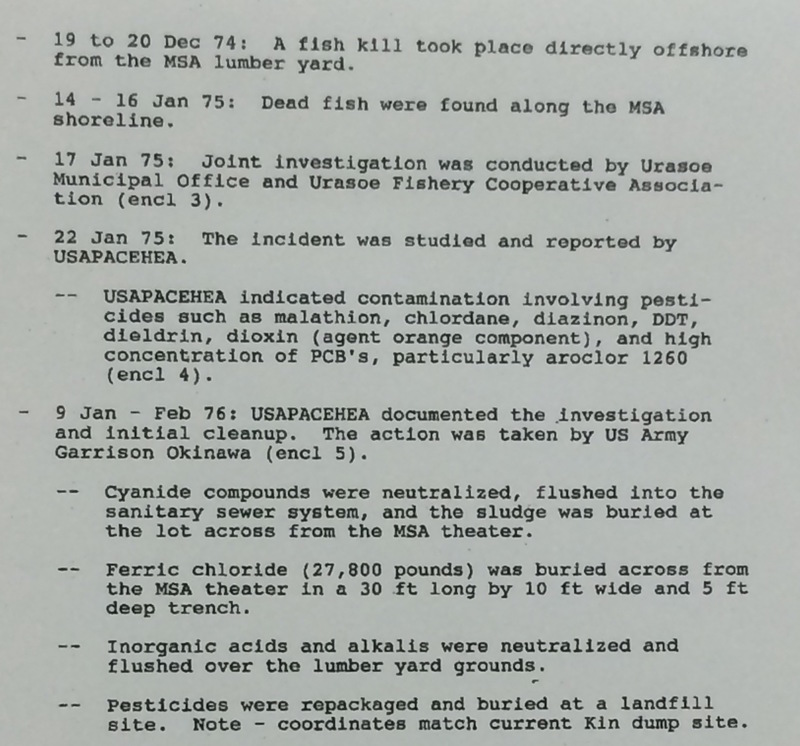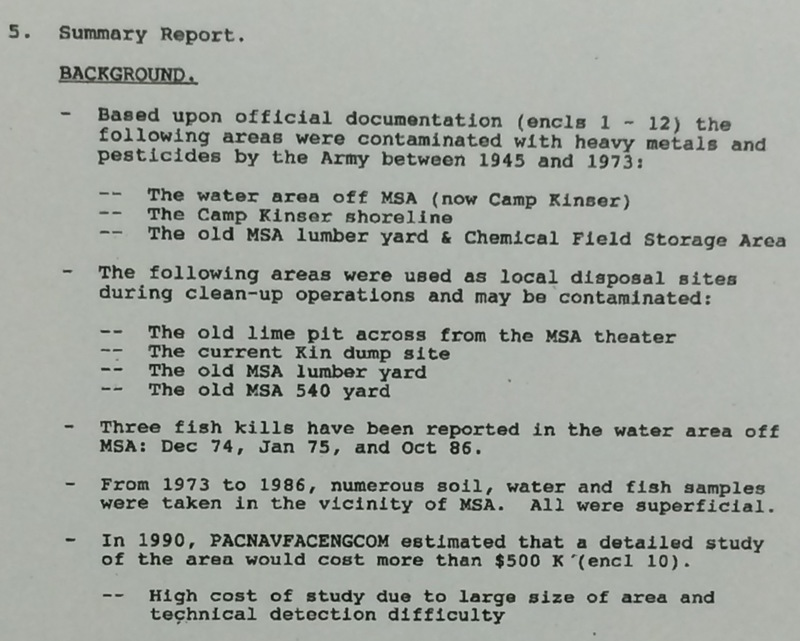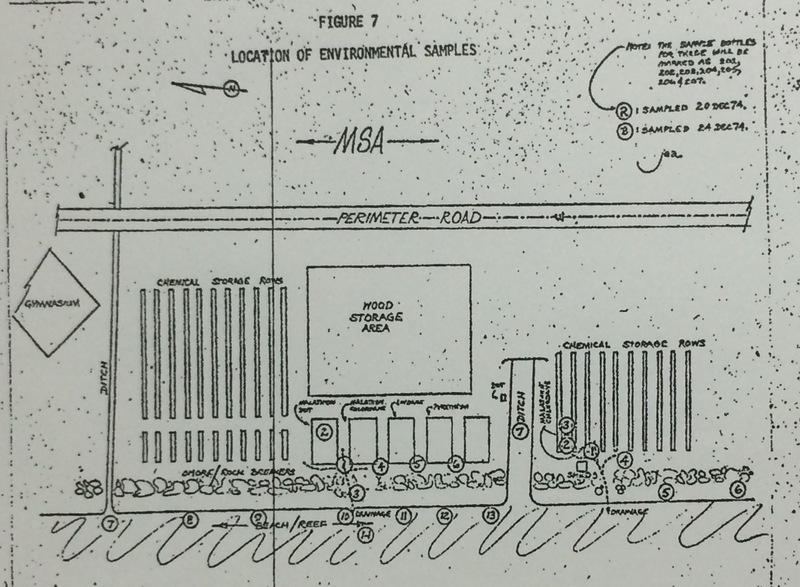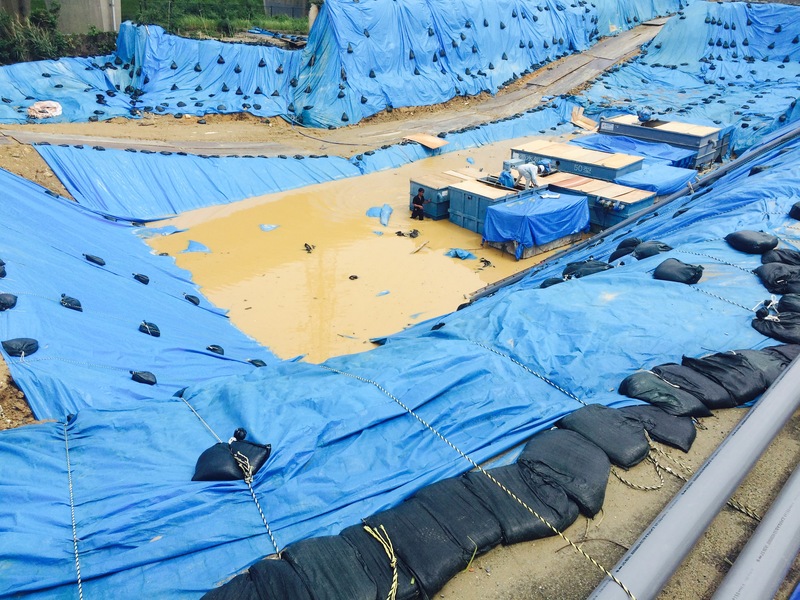FOIA Documents Reveal Agent Orange Dioxin, Toxic Dumps, Fish Kills on Okinawa Base. Two Veterans Win Compensation, Many More DeniedThe Asia-Pacific Journal, Vol. 13, Issue. 39, No. 1, October 5, 2015Jon MitchellDocuments released in September 2015 by the Pentagon under the Freedom of Information Act reveal that Agent Orange dioxin was discovered at the U.S. Army’s Machinato Service Area (MSA), Urasoe City, Okinawa, in the 1970s.1 The 82 pages of reports produced by the U.S. Army, Navy and Marine Corps focus on a 46,000 square-metre outdoor storage area within the base which was used to store “retrograde shipments from Viet-Nam” (1) – including herbicides – during the 1960s and 1970s. Following tests of the soil and water in the mid-1970s, USMC documents cite the discovery of a “high concentration” of dioxin in the area (77); a United States Forces Japan report specifies the detection of “dioxin (agent orange component)” in 1975 (2). The findings contradict Pentagon assertions as recently as 2015 that Agent Orange was never stored on Okinawa.2 Hundreds of U.S. veterans who served on Okinawa during the Vietnam War believe they were sickened by exposure to military defoliants on the island; many of them claim that there was a large stockpile of Agent Orange at MSA.3 Due to Pentagon denials that these chemicals were present on Okinawa, the Department of Veterans Affairs has refused to award compensation to the vast majority of these former service members. The revelation that the Agent Orange dioxin was discovered at MSA – which is known today as Camp Kinser – comes at the end of an 18-month struggle under the Freedom of Information Act during which the Pentagon initially refused to release the records for reasons which included the need “to protect against public confusion.”4 On September 23rd, United States Pacific Command finally released the package, titled “Talking Paper on Possible Toxic Contamination at Camp Kinser,” dated 30 July 1993. The FOIA release is believed to be the first time such comprehensive records regarding U.S. military contamination in Japan have been made public. In addition to dioxin contamination, the reports also reveal deaths of sea life, burials of toxic chemicals and the possible exposure of base workers at MSA. Furthermore, they highlight the frustrations of the U.S. military struggling to tackle contamination in the face of previous failed clean-ups and bureaucratic obstacles.
During the Vietnam War, Okinawa – under U.S. jurisdiction until 1972 – served as the military’s most important staging post for the conflict. Supplies were funneled through the island on the way to Southeast Asia – but also surplus and damaged materiel was returned to Okinawa for processing or disposal.5 According to the documents, among the substances stored were “insecticides, rodenticides, herbicides, inorganic and organic acids, alkalis, inorganic salts, organic solvents, and vapor degreasers” (33). The FOIA-released reports explain these chemicals were stored outdoors along the shoreline of MSA where their condition deteriorated. Okinawan officials visiting the yard described hundreds of barrels, boxes and plastic bags of unknown substances: “Chemicals leaked from the rusted vessels contaminated the area. Marks of leaked chemical meet eyes at every turn” (22). The military apparently told Okinawan officials that most of the containers held the comparatively non-toxic insecticide, malathion. A 1991 USMC report also reveals that U.S. authorities had attempted to sell surplus chemical stocks to Okinawan civilians, but “Many containers were in such poor condition that bidder refused to pick them up” (33). In 1974 and 1975, large “fish kills” on the nearby coast prompted the U.S. Army Pacific Environmental Health Engineering Agency to conduct surveys of the sea and soil. The results “indicated high concentration of chlordane, DDT, malathion, dioxin and polychlorinated biphenyl” (77). The pesticides chlordane and DDT have both been banned due to health risks; dioxins and PCBs have long been recognised as harmful and they can remain dangerous for decades when buried. Subsequent tests on Camp Kinser in 1978 also revealed high levels of carcinogenic heavy metals such as lead and cadmium (42). According to the FOIA-released records, in an attempt to mitigate the contamination, large quantities of the stockpiled chemicals were buried or “flushed” on the base – including sludge from neutralised cyanide compounds, inorganic acids and alkalis and 12.5 tons of ferric chloride. Pesticides were also buried at USMC Camp Hansen, Kin Town (2). In total, the documents reveal three areas of large scale contamination and four dumpsites (5). Reports show how the military’s optimism that these initial cleanup attempts had been successful soon turned to dismay. In the mid-1980s, during a civilian landfill project, toxins again seeped from the base resulting in the further death of marine life (35). Documents written by military personnel in the 1980s and 1990s reveal their dissatisfaction with predecessors’ remediation attempts. Labeling the surveys “superficial” (5) and “cursory” (6), they criticize the lack of follow-up checks and the failure to record whether the contaminated soil was ever removed from the installation (77). A September 1984 report written by the Commanding Officer of Navy hospital on Okinawa raises concerns that construction workers might have been exposed to toxins during the building of a new medical centre on the base. The commander appeared particularly concerned about high levels of PCBs which he described as “highly toxic, a suspected carcinogen, extremely persistent and virtually indestructible in the natural environment”6 (49). In December 1984, the discovery of elevated heavy metal levels on the shore 2.2 km from the storage site also seems to have compounded fears of the potential impact on communities beyond the installation (52). In 1984, the Navy reported that no herbicides were “found or detected” (53) but it appears to have taken the threat of defoliant contamination seriously enough to order a series of dioxin checks for the base. The reports do not specify on which part of Camp Kinser these checks were conducted; the tests came back negative (59). As recently as 1990, one Navy commander wrote that he suspected toxic “hot spots” still existed within Camp Kinser. “Detection of these hot spots would be extremely difficult and require extensive sampling,” he explained (73). At the time, the military was considering building a pleasure beach for service members on the base. The military abandoned the plan in 1990: “The use of a former hazardous material storage site where past release is known to have occurred is not recommended because of the large potential liability in the event a user developed adverse health problems” (73). Included in the FOIA package are several charts pinpointing the contaminated area (8 ~ 13). Crosschecked against current maps of Camp Kinser, it appears that today a bowling alley, medical centre and baseball field sit upon the site. Additionally, civilian reclamation work has filled in the sea neighboring the former storage yard. Under plans to consolidate the U.S. presence on Okinawa, Tokyo and Washington intend to return the bulk of Camp Kinser in 2024 “or later”. However, the return of a 2-hectare parcel of land, near the base’s Gate 5, is now overdue its scheduled return date of 2014.7 That land appears to be located within – and directly adjacent to – the contaminated zone. Komichi Ikeda, adviser at Environmental Research Institute Inc., Tokyo, expressed concerns that, given the persistence and toxicity of the chemicals involved, the land may still be polluted. “Depending on the concentration of the substances and their interaction with the environment, they might still pose a danger. It’s important for the U.S. to follow current EPA guidelines and survey the land for possible contamination before it is returned to civilian use,” she said. In addition to scientific data, the FOIA-released reports also provide insight into the hurdles the U.S. military faces dealing with contamination on its bases in Japan. In 1990, the Navy estimated that a full survey of the former storage site would cost more than $500,000 (approx. 112 million yen in 2015 terms), but it warned any actual remediation would cost much more (73). According to the reports, such funding would be difficult to obtain because some Pentagon clean-up budgets were reserved for projects within the U.S. Furthermore, there were not enough personnel available to conduct a survey of the size required for Camp Kinser (74). Then – as today – the U.S.-Japan Status of Forces Agreement relieves Washington of all costs of remediating land returned to public usage. On September 28, Tokyo and Washington inked a new environmental pact which will theoretically allow Japanese officials to request access to U.S. bases in the case of chemical spills or to conduct surveys of land scheduled for return.8 Dr. Kawamura Masami, director of Citizens’ Network for Biodiversity in Okinawa, has been leading efforts to ensure Tokyo and Washington are more transparent about the environmental impact of U.S. bases on the island. “The new pact has been described as a way to reduce Okinawa’s military burden but it will do nothing to solve environmental problems. The wording is vague and it still gives the U.S. strong discretionary powers. USFJ and Tokyo ought to prioritize the rights of the people affected by contamination,” she said. Kawamura also criticised the timing of the announcement and the way the pact was formulated. “The U.S. and Japan released the news of the pact when the Governor of Okinawa was to cancel the approval of the reclamation of Oura Bay for the new base at Henoko.It appears that the two governments are using this pactas a political tool. Secondly, the process of finalizing the pact was unacceptable.They failed to make public the details – indicating that the two governments ignored the needs of the affected communities.” Kawamura expressed concerns not only for 114,000 Okinawans residing in Urasoe City alongside Camp Kinser but also the service members and their families – past and present – stationed on the installation. Today, Camp Kinser contains an elementary school and accommodation for service members and their dependents; approximately 1000 base employees work on the base. In recent years, the environmental safety record of Camp Kinser has been under the spotlight. In 2009, six Japanese workers fell ill following exposure to an unknown substance at a warehouse on the base.9 In 2013, mongooses caught near the installation showed high levels of poisonous PCBs while, in September 2015, scientists from Meio University and Ehime University reported that habu snakes in the vicinity of Camp Kinser were also found to contain elevated concentrations of PCBs and the banned insecticide, DDT. In response to the habu report, the mayor of Urasoe, Tetsuji Matsumoto, ordered tests on local water and announced he’d ask Tokyo for a full investigation.10 Two more Okinawa veterans win compensation Despite Pentagon assertions that Agent Orange was never present on Okinawa, the U.S. government has awarded compensation to two more service members who believe they were sickened by the substance while stationed on the island. In April 2015, the Board of Veterans Appeals ruled that a former U.S. marine had developed multiple myeloma due to herbicide exposure.11 The unnamed veteran – a member of the 3rd Marine, 9th Motors, 3rd Fort Service Support Group – was stationed on an unspecified base on Okinawa between 1976 and 1977. The veteran claims to have come into contact with Agent Orange in a number of ways. He testified that barrels of defoliants passed through the island on the way for final disposal in Johnston Island and he was also tasked with processing contaminated equipment from the war in Vietnam. In addition, he sprayed his installation in order to kill vegetation. Following his service on Okinawa, the veteran was stationed at Fort A.P. Hill, Virginia, where he also came into contact with herbicides. In support of his winning claim, the veteran supplied EPA memoranda related to Fort A.P. Hill and photographs of the vehicles which he drove on Okinawa to transport the barrels of herbicides. The second veteran to win compensation is retired Lt. Col. Kris Roberts, the Marine at the centre of allegations that Agent Orange had been dumped on Futenma Air Base, Ginowan City.12 On August 10, the Board of Veterans’ Appeals ruled that Roberts, chief of maintenance at the installation in the early 1980s, had developed prostate cancer due to “exposure to hazardous chemicals.” The presiding judge based the decision on evidence which included medical reports, statements and “photographs of barrels being removed from the ground.” However, the carefully worded ruling avoids specific reference to Agent Orange. Now, Roberts is urging the military to come clean about what really happened at Futenma. “The Marine Corps has a moral and ethical obligation to alert others who may have been exposed,” he said in an interview with the author. According to Roberts, in 1981 he was ordered to investigate high chemical readings detected in waste water running from the installation into neighboring communities. After checking the area of concern near one of the base’s runways, Roberts and his team unearthed more than 100 chemical barrels – some marked with the tell-tale orange stripes of defoliants. On orders from Futenma’s top brass, the barrels were moved by Okinawan base workers to an undisclosed location. After the discovery, Roberts developed a number of serious illnesses, including heart disease and prostate cancer. Roberts, who is a state representative in New Hampshire, believes that the Marine Corps has a duty to track down the service members and Japanese military employees who handled the toxic barrels. He also called on USFJ to inform local residents. “The base’s drainage pipes distributed the contaminated water all around the civilian communities near Futenma – not only in Ginowan City. USFJ needs to warn them of the dangers – and doctors need to look for clusters of diseases similar to the ones I have,” he said. Asked whether USFJ would notify others potentially poisoned, on September 16, Tiffany Carter, USFJ Media Relations Chief, replied “We are aware of the news reports, but will refer you to the Veterans Administration for further comments.”13 According to publicly available Department of Veterans’ Affairs records, more than 200 U.S. veterans believe they were poisoned by Agent Orange while serving on Okinawa. Their sicknesses include multiple myeloma, Parkinson’s disease and peripheral neuropathy – illnesses for which the Department of Veterans’ Affairs compensates Americans exposed to defoliants in Vietnam, Thailand and the Korean DMZ. Although photographs and military documents corroborate claims that defoliants were present on Okinawa, Washington maintains no such evidence exists – and has not yet commented on the FOIA-release citing Agent Orange dioxin. To date, only a handful of U.S. veterans have been awarded compensation for exposure to Agent Orange on Okinawa.14
As well as the Camp Kinser report package, veterans’ hopes have been buoyed by the discovery of more than 100 buried barrels in Okinawa City on land that used to be part of Kadena Air Base, the Pentagon’s busiest Okinawa installation during the Vietnam War. Some of the barrels – which first began to be unearthed in June 2013 – contained traces of Agent Orange’s three ingredients: the herbicides 2,4,5-T and 2,4-D, and TCDD dioxin. Japanese and international experts assert that the discovery proves that military defoliants were present on Okinawa.15 In June, the most recent tests revealed that some of the standing water near the barrels contained levels of dioxin thousands of times higher than environmental standards.16 Meanwhile, the Okinawan authorities’ handling of the ongoing cleanup has come under fire. Construction workers at the dumpsite wear little protective clothing and the plastic tarpaulins covering the excavation allow water to accumulate. In July, a typhoon flooded the site – and the water was apparently pumped into a nearby river without first being checked for contamination.17 Parts of this article originally appeared in The Japan Times on August 17, September 16 and September 29. In May 2015, Welsh journalist, Jon Mitchell, was awarded the Foreign Correspondents’ Club of Japan Freedom of the Press Award for Lifetime Achievement for his reporting about human rights issues – including military contamination – on Okinawa. He is the author of Tsuiseki: Okinawa no Karehazai (Chasing Agent Orange on Okinawa) (Koubunken 2014) and a visiting researcher at the International Peace Research Institute of Meiji Gakuin University, Tokyo. Mitchell is an Asia-Pacific Journal contributing editor. Recommended citation: Jon Mitchell, “FOIA Documents Reveal Agent Orange Dioxin, Toxic Dumps, Fish Kills on Okinawa Base. Two Veterans Win Compensation, Many More Denied”, The Asia-Pacific Journal, Vol. 13, Issue 39, No. 1, October 5, 2015. Notes 1. Page references in this paper correspond to the pdf file released by PACOM under FOIA titled “Joint Environmental Investigative Committee, Talking Paper on Possible Toxic Contamination at Camp Kinser, Environmental Branch (J42E); U.S. Forces Japan, Yokota Air Base, Japan (30 July 1993)”. The document is available here. USPACOM have given assurances that this is the full report and the best quality available. However, there are a number of concerns with the released documents: the legibility of some pages is poor, some reports appear to have been cut during reproduction, sections are missing and, most significantly, the 12 enclosures do not correspond to those outlined in pages 1 to 6. 2. In an email to the author dated 5 October 2011, USFJ stated: “In response to the Embassy of Japan request on August 10, DOD has once again searched and once again been unable to locate any record of Herbicide Orange or its component ingredients being used in Okinawa.” The recently released FOIA records – with their specific mention of the discovery of “dioxin (agent orange component)” – suggest that the Pentagon may have been misleading the Japanese government on the issue. For a wider discussion of the Pentagon’s ongoing denials of this issue, see Jon Mitchell, “‘Deny, deny until all the veterans die’ – Pentagon investigation into Agent Orange on Okinawa,” The Asia-Pacific Journal, Vol. 11, Issue 23, No. 2. June 10, 2013. Available here. 3. Jon Mitchell, “US Military Defoliants on Okinawa: Agent Orange,”The Asia-Pacific Journal Vol 9, Issue 37 No 5, September 12, 2011. Available here. 4. Jon Mitchell, “Pentagon blocks report on ‘toxic contamination’ at base outside Okinawa capital”, The Japan Times, September 16, 2015. Available here. 5. Jon Mitchell, “Okinawa – The Pentagon’s Toxic Junk Heap of the Pacific,” The Asia-Pacific Journal, Vol. 11, Issue 47, No. 6, November 25, 2013. Available here. 6. In 1987, PCB-contamination at Kadena Air Base was concealed by the Pentagon; the truth emerged after a whistle-blower released internal documents related to the incident. Jon Mitchell, “Military Contamination on Okinawa: PCBs and Agent Orange at Kadena Air Base”, The Asia-Pacific Journal, Vol. 12, Issue 12, No. 1, March 24, 2014. Available here. 7. “Consolidation Plan for Facilities and Areas in Okinawa”, MOFA, April 2013, Available here. 8. For further information on the pact – and its inadequacies – see Masaaki Kameda, “U.S.-Japan environmental agreement on U.S. bases flawed, experts say”, The Japan Times, September 29, 2015. Available here. 9. David Allen, “Hazmat Team Investigates Odor at Kinser Warehouse”, Stars and Stripes, April 30, 2009. 10. For example, see the September 7, 2015 letter from the Mayor of Urasose City to the Commanding General of III Marine Expeditionary Force here. 11. The BVA ruling – Citation Nr: 1516681 – can be read here. 12. Jon Mitchell, “Agent Orange at Okinawa’s Futenma Base in 1980s,” The Asia-Pacific Journal, Vol 10, Issue 25, No. 3, June 18, 2012. Available here. 13. Email exchange with the author dated September 16, 2015. 14. Jon Mitchell, “Ailing U.S. veteran wins payout over Agent Orange exposure in Okinawa,” The Japan Times, March 17, 2014. Available here. 15. Jon Mitchell, “Okinawa Dumpsite Offers Proof of Agent Orange: Experts Say,” The Asia-Pacific Journal, Issue 38, No. 1, September 23, 2013. Available here. 16. For example, see this Ryukyu Shimpo article – “Dioxin 21,000 times regular levels in Okinawa City barrel” – June 30, 2015, available here. 17. For example, see this QAB news report – “Possible contamination of flooded soil at Okinawa City soccer pitch” – July 13, 2015, available here. | ||||||






Leave a Reply
You must be logged in to post a comment.